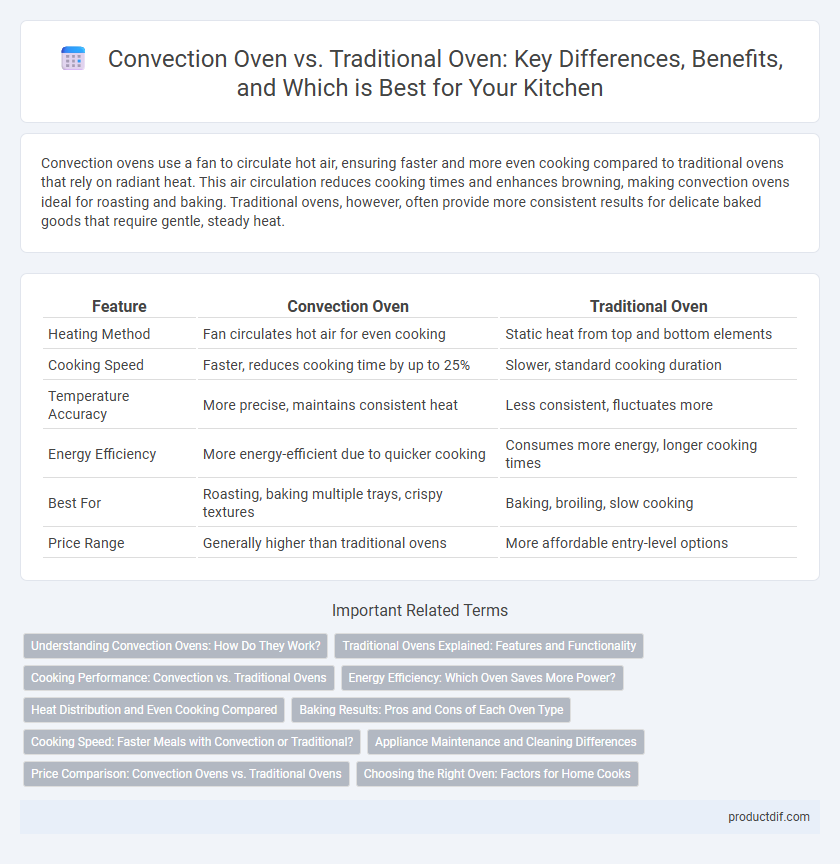Convection ovens use a fan to circulate hot air, ensuring faster and more even cooking compared to traditional ovens that rely on radiant heat. This air circulation reduces cooking times and enhances browning, making convection ovens ideal for roasting and baking. Traditional ovens, however, often provide more consistent results for delicate baked goods that require gentle, steady heat.
Table of Comparison
| Feature | Convection Oven | Traditional Oven |
|---|---|---|
| Heating Method | Fan circulates hot air for even cooking | Static heat from top and bottom elements |
| Cooking Speed | Faster, reduces cooking time by up to 25% | Slower, standard cooking duration |
| Temperature Accuracy | More precise, maintains consistent heat | Less consistent, fluctuates more |
| Energy Efficiency | More energy-efficient due to quicker cooking | Consumes more energy, longer cooking times |
| Best For | Roasting, baking multiple trays, crispy textures | Baking, broiling, slow cooking |
| Price Range | Generally higher than traditional ovens | More affordable entry-level options |
Understanding Convection Ovens: How Do They Work?
Convection ovens utilize a built-in fan and exhaust system to circulate hot air evenly throughout the cooking chamber, ensuring consistent temperatures and faster cooking times compared to traditional ovens. This airflow technology enhances heat transfer, resulting in better browning, crisping, and energy efficiency. Unlike traditional ovens, which rely on radiant heat from heating elements, convection ovens maintain uniform heat distribution that minimizes hot spots and improves overall cooking performance.
Traditional Ovens Explained: Features and Functionality
Traditional ovens utilize radiant heat from electric coils or gas burners to cook food evenly within an insulated chamber. These appliances feature adjustable temperature controls, manual settings for bake, broil, and roast, and often include a timer for precise cooking durations. The even heat distribution in traditional ovens is ideal for baking bread, roasting meats, and casseroles, allowing consistent texture and flavor development.
Cooking Performance: Convection vs. Traditional Ovens
Convection ovens use a fan to circulate hot air, resulting in faster, more even cooking and consistent browning compared to traditional ovens. Traditional ovens rely on radiant heat, which can lead to uneven temperature distribution and longer cooking times. This makes convection ovens ideal for roasting and baking where uniform heat is critical for optimal texture and flavor.
Energy Efficiency: Which Oven Saves More Power?
Convection ovens use a fan to circulate hot air, enabling faster and more even cooking, which reduces overall cooking time and energy consumption compared to traditional ovens. Traditional ovens rely on radiant heat without air circulation, often requiring longer preheating and cooking times, leading to higher energy usage. Studies show convection ovens can save up to 20% on energy, providing a more efficient option for power savings in kitchen appliances.
Heat Distribution and Even Cooking Compared
Convection ovens utilize a built-in fan and exhaust system to circulate hot air evenly around the food, resulting in faster and more uniform cooking compared to traditional ovens. Traditional ovens rely on stationary heat sources, such as heating elements at the top and bottom, which can create hot spots and uneven temperature distribution. This difference in heat distribution makes convection ovens ideal for baking and roasting, ensuring consistent browning and improved texture.
Baking Results: Pros and Cons of Each Oven Type
Convection ovens utilize a fan to circulate hot air, resulting in faster and more even baking with a crispier texture, making them ideal for roasting and baking pastries. Traditional ovens rely on radiant heat, offering consistent temperature ideal for delicate baked goods like cakes and custards that require gentle, even cooking. Each oven type has pros and cons: convection ovens can dry out some foods if not monitored closely, while traditional ovens may have hot spots leading to uneven baking.
Cooking Speed: Faster Meals with Convection or Traditional?
Convection ovens cook meals faster due to a built-in fan that circulates hot air evenly, reducing cooking time by up to 25% compared to traditional ovens. Traditional ovens rely on stationary heat, which can result in longer cooking durations and uneven heat distribution. For busy kitchens aiming to speed up meal preparation, convection ovens offer a clear advantage in efficiency.
Appliance Maintenance and Cleaning Differences
Convection ovens require more frequent cleaning of the fan and exhaust system to prevent grease buildup, ensuring optimal airflow and even cooking. Traditional ovens primarily need routine wiping of heating elements and interior surfaces, with less emphasis on ventilation components. Both appliances benefit from regular deep cleaning, but convection ovens demand additional attention to their mechanical parts for sustained performance.
Price Comparison: Convection Ovens vs. Traditional Ovens
Convection ovens typically cost between $200 and $1,000, offering advanced heat circulation for faster, more even cooking, while traditional ovens range from $150 to $800, often priced lower due to simpler technology. The higher initial investment in convection ovens is balanced by energy efficiency and reduced cooking times, potentially lowering long-term utility costs. Price variations depend on brand, size, and additional features, making convection models generally more expensive but justified by enhanced performance and durability.
Choosing the Right Oven: Factors for Home Cooks
Convection ovens use a fan to circulate hot air, providing even cooking and reducing cooking times, making them ideal for baking and roasting. Traditional ovens rely on radiant heat, offering consistent temperatures that are simpler for slow cooking and recipes requiring gentle heat. Home cooks should consider factors like cooking style, recipe types, energy efficiency, and budget when choosing between convection and traditional ovens.
Convection Oven vs Traditional Oven Infographic

 productdif.com
productdif.com